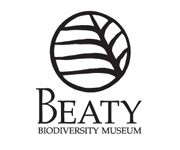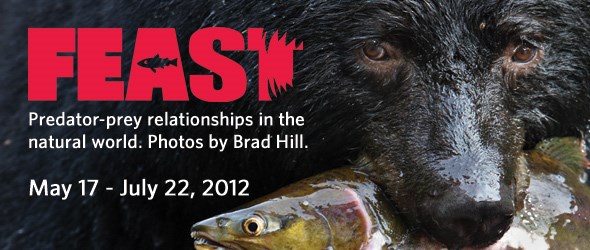 |
The Beaty Biodiversity Museum is Vancouver’s natural history museum, dedicated to creating a shared sense of community and wonder. The museum puts UBC's natural history collections, with more than two million specimens, on public view for the first time. Among our treasures are a 26-metre-long blue whale skeleton suspended in the Djavad Mowafaghian Atrium, the third-largest fish collection in the nation, and myriad fossils, shells, insects, fungi, mammals, birds, reptiles, amphibians, and plants from around British Columbia and the world. Come visit us at 2212 Main Mall, Vancouver, BC. You can find more info at beatymuseum.ubc.ca or sign up for our e-newsletter. |
Feast:
Predator-Prey Relationships in the natural world. Photos by Brad Hill.
May 17 - July 22, 2012
To eat or be eaten? Through stunning photographs, internationally acclaimed nature photographer Brad Hill presents an intimate look at animals feasting in the wild. Whether in the air, on land, or in water, Brad addresses the challenge of photographing wild and unpredictable animals at one of their most fundamental behaviours.
Witness a raven thief making off with a goose egg in its beak, stare into the eyes of a grey wolf hungrily licking its lips, and marvel at a circus of dolphins chasing a salmon. Explore the true omnivorous diet of bears. Brad’s photographs include striking images of bears fishing for salmon, but they also reveal other feeding behaviours, including climbing trees for berries, grazing on grass, digging for roots, and even gnawing on the bones of other bears. These unique moments were all captured in Canada, predominantly in BC.
Within this collection, there are images captured in a coastal region of BC that has become known as the Great Bear Rainforest. It is one of the largest tracts of unspoiled temperate rainforest left on earth and is home to grizzly bears, black bears, spirit bears (rare white-phased black bears), coastal grey wolves, almost countless species of birds, and flourishing populations of many types of aquatic mammals. This ecosystem is driven by the energy and nutrient input provided by millions of salmon that return to their natal streams to spawn each year.
“It's about striving to find and expose the art inherent in nature. It's about increasing the awareness of the beauty, fragility and ephemerality of the natural world.” –Brad Hill
Biography
Brad Hill is an internationally renowned nature photographer with a focus on conservation. He resides in the southern Columbia Valley of BC, wedged between the Rocky Mountains to the east and the Purcells to the west; an area sometimes known as the "Serengeti of North America." He shares his life with his longtime partner Patti and their two almost human Portuguese Water Dogs - Diego and Jose.
Formally trained as a wildlife biologist with a speciality in animal behavior, Brad’s professional journey eventually led him back to nature as a full-time conservation and nature photographer in 2005. He currently concentrates his photographic efforts in North America and, in particular, western Canada.
Brad’s work has been recognized by numerous international organisations, and awards for his photographs include Wildlife Image of the Year (Nature Photographer's Network, 2008) and Most Creative Nature Image (Creative Nature Photographers, 2009). He is also the Lead Moderator in the Wildlife Gallery of Nature Photographer's Network, the largest online community of nature photographers on the planet. www.naturalart.ca



